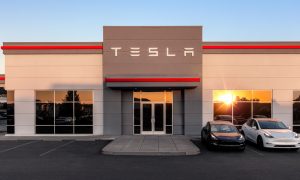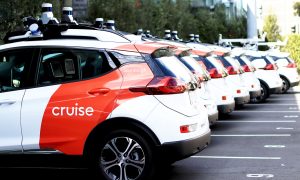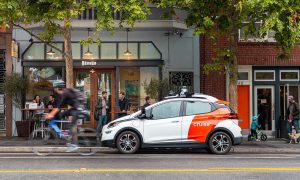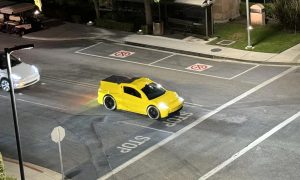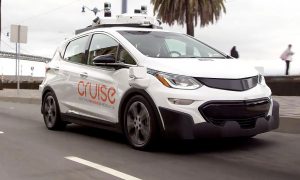

News
Cruise in hot seat amid Fire Department’s claims that robotaxis delayed responders in fatal incident
General Motors’ self-driving unit, Cruise, saw protests outside its San Francisco headquarters earlier this week. The protests come amidst the San Francisco Fire Department’s claims that some of the company’s autonomous robotaxis contributed to the tragic death of a pedestrian.
The incident, which happened on August 14, involved a pedestrian who was hit by a car in the South of Market neighborhood of San Francisco. The pedestrian’s injuries were so severe that there was heavy bleeding, and the person was no longer responding to verbal commands. It was evident that the injured pedestrian needed urgent medical care, so it was pertinent to have the person transported to a hospital as early as possible.
Public reports from the San Francisco Fire Department that were obtained by Forbes claimed that the behavior of Cruise robotaxis ended up impeding the workflow of emergency responders, so much so that critical medical care was delayed. One of the Fire Department’s reports about the incident reads as follows.
“On 8/14/2023, I was assigned to Medic 87 and responded to Incident FD23108420, at 7th Street and Harrison, for an auto vs. pedestrian. Harrison Street is 4 lanes of one-way traffic heading westbound. Upon arrival on scene, the victim was found in the (2) left lanes of Harrison Street, suffering from life-threatening injuries. SFPD and E01 had arrived prior to M87’s arrival. SFPD had a vehicle parked in the #1 lane of Harrison, and E01 had positioned its apparatus across the left 2 lanes of Harrison to shield the patient from oncoming traffic. The right 2 lanes of Harrison were blocked by (2) autonomous Cruise vehicles that had stopped and were not moving, blocking ingress and egress to the incident scene.
“The patient was suffering from life-threatening injuries, with a GCS 3, agonal respirations, and absent peripheral pulses. SFPD had applied a tourniquet to the left lower extremity to stop life-threatening bleeding from injuries sustained after being struck by a vehicle. Ventilations were assisted with a BVM, and the patient was packaged for rapid transport to a trauma center.
“While loading the patient to the ambulance, the (2) Cruise vehicles were still stopped in the right 2 lanes of Harrison, prohibiting rapid egress from the scene. SFPD had attempted manual takeover of the autonomous vehicles, but were unsuccessful. This contributed to a delay in transport with a critical trauma patient.
“SFFD members had to locate an SFPD officer and request him to move his vehicle to allow successful egress from the scene, but doing so further delayed patient care. These delays caused by (2) autonomous vehicles blocking a normal egress route from the scene contributed to a poor patient outcome, delaying the definitive care required in severe trauma cases. The patient was pronounced deceased at SFGH approximately 20-30 minutes after arrival due to severe blunt-force trauma.”
Cruise has spoken out against the Fire Department’s account of the event. In a comment to The San Francisco Standard, a Cruise spokesperson noted that “we did not impede the vehicle from getting to the hospital” and “what the fire department said is not accurate.”
“The first vehicle promptly clears the area once the light turns green and the other stops in the lane to yield to first responders who are directing traffic. Throughout the entire duration the AV is stopped, traffic remains unblocked and flowing to the right of the AV. The ambulance behind the AV had a clear path to pass the AV as other vehicles, including the ambulance, proceeded to do so. As soon as the victim was loaded into the ambulance, the ambulance left the scene immediately and was never impeded from doing so by the AV,” Cruise noted in a statement.
Cruise has reportedly provided a video to back up its claims. The video reportedly showed that while one Cruise robotaxi was indeed stopped at an intersection, there was a free lane to its right where traffic was moving. The video, which was reviewed by Forbes, did show numerous vehicles, including a small ambulance, moving through the free lane. However, the publication noted that it was not clear from the footage if the larger SFFD ambulance, which was likely transporting the severely injured pedestrian, could have navigated the area as easily.
Below are incident reports from the San Francisco Fire Department. The case in question is described in Page 68 and 69 of the document.
Cruise San Francisco Reports by Simon Alvarez on Scribd
Don’t hesitate to contact us with news tips. Just send a message to simon@teslarati.com to give us a heads-up.
Elon Musk
Why Tesla’s Q3 could be one of its biggest quarters in history
Tesla could stand to benefit from the removal of the $7,500 EV tax credit at the end of Q3.

Tesla has gotten off to a slow start in 2025, as the first half of the year has not been one to remember from a delivery perspective.
However, Q3 could end up being one of the best the company has had in history, with the United States potentially being a major contributor to what might reverse a slow start to the year.
Earlier today, the United States’ House of Representatives officially passed President Trump’s “Big Beautiful Bill,” after it made its way through the Senate earlier this week. The bill will head to President Trump, as he looks to sign it before his July 4 deadline.
The Bill will effectively bring closure to the $7,500 EV tax credit, which will end on September 30, 2025. This means, over the next three months in the United States, those who are looking to buy an EV will have their last chance to take advantage of the credit. EVs will then be, for most people, $7,500 more expensive, in essence.
The tax credit is available to any single filer who makes under $150,000 per year, $225,000 a year to a head of household, and $300,000 to couples filing jointly.
Ending the tax credit was expected with the Trump administration, as his policies have leaned significantly toward reliance on fossil fuels, ending what he calls an “EV mandate.” He has used this phrase several times in disagreements with Tesla CEO Elon Musk.
Nevertheless, those who have been on the fence about buying a Tesla, or any EV, for that matter, will have some decisions to make in the next three months. While all companies will stand to benefit from this time crunch, Tesla could be the true winner because of its sheer volume.
If things are done correctly, meaning if Tesla can also offer incentives like 0% APR, special pricing on leasing or financing, or other advantages (like free Red, White, and Blue for a short period of time in celebration of Independence Day), it could see some real volume in sales this quarter.
You can now buy a Tesla in Red, White, and Blue for free until July 14 https://t.co/iAwhaRFOH0
— TESLARATI (@Teslarati) July 3, 2025
Tesla is just a shade under 721,000 deliveries for the year, so it’s on pace for roughly 1.4 million for 2025. This would be a decrease from the 1.8 million cars it delivered in each of the last two years. Traditionally, the second half of the year has produced Tesla’s strongest quarters. Its top three quarters in terms of deliveries are Q4 2024 with 495,570 vehicles, Q4 2023 with 484,507 vehicles, and Q3 2024 with 462,890 vehicles.
Elon Musk
Tesla Full Self-Driving testing continues European expansion: here’s where
Tesla has launched Full Self-Driving testing in a fifth European country ahead of its launch.

Tesla Full Self-Driving is being tested in several countries across Europe as the company prepares to launch its driver assistance suite on the continent.
The company is still working through the regulatory hurdles with the European Union. They are plentiful and difficult to navigate, but Tesla is still making progress as its testing of FSD continues to expand.
Today, it officially began testing in a new country, as more regions open their doors to Tesla. Many owners and potential customers in Europe are awaiting its launch.
On Thursday, Tesla officially confirmed that Full Self-Driving testing is underway in Spain, as the company shared an extensive video of a trip through the streets of Madrid:
Como pez en el agua …
FSD Supervised testing in Madrid, Spain
Pending regulatory approval pic.twitter.com/txTgoWseuA
— Tesla Europe & Middle East (@teslaeurope) July 3, 2025
The launch of Full Self-Driving testing in Spain marks the fifth country in which Tesla has started assessing the suite’s performance in the European market.
Across the past several months, Tesla has been expanding the scope of countries where Full Self-Driving is being tested. It has already made it to Italy, France, the Netherlands, and Germany previously.
Tesla has already filed applications to have Full Self-Driving (Supervised) launched across the European Union, but CEO Elon Musk has indicated that this particular step has been the delay in the official launch of the suite thus far.
In mid-June, Musk revealed the frustrations Tesla has felt during its efforts to launch its Full Self-Driving (Supervised) suite in Europe, stating that the holdup can be attributed to authorities in various countries, as well as the EU as a whole:
Tesla Full Self-Driving’s European launch frustrations revealed by Elon Musk
“Waiting for Dutch authorities and then the EU to approve. Very frustrating and hurts the safety of people in Europe, as driving with advanced Autopilot on results in four times fewer injuries! Please ask your governing authorities to accelerate making Tesla safer in Europe.”
Waiting for Dutch authorities and then the EU to approve.
Very frustrating and hurts the safety of people in Europe, as driving with advanced Autopilot on results in four times fewer injuries!
Please ask your governing authorities to accelerate making Tesla safer in Europe. https://t.co/QIYCXhhaQp
— Elon Musk (@elonmusk) June 11, 2025
Tesla said last year that it planned to launch Full Self-Driving in Europe in 2025.
Elon Musk
xAI’s Memphis data center receives air permit despite community criticism
xAI welcomed the development in a post on its official xAI Memphis account on X.

Elon Musk’s artificial intelligence startup xAI has secured an air permit from Memphis health officials for its data center project, despite critics’ opposition and pending legal action. The Shelby County Health Department approved the permit this week, allowing xAI to operate 15 mobile gas turbines at its facility.
Air permit granted
The air permit comes after months of protests from Memphis residents and environmental justice advocates, who alleged that xAI violated the Clean Air Act by operating gas turbines without prior approval, as per a report from WIRED.
The Southern Environmental Law Center (SELC) and the NAACP has claimed that xAI installed dozens of gas turbines at its new data campus without acquiring the mandatory Prevention of Significant Deterioration (PSD) permit required for large-scale emission sources.
Local officials previously stated the turbines were considered “temporary” and thus not subject to stricter permitting. xAI applied for an air permit in January 2025, and in June, Memphis Mayor Paul Young acknowledged that the company was operating 21 turbines. SELC, however, has claimed that aerial footage shows the number may be as high as 35.
Critics are not giving up
Civil rights groups have stated that they intend to move forward with legal action. “xAI’s decision to install and operate dozens of polluting gas turbines without any permits or public oversight is a clear violation of the Clean Air Act,” said Patrick Anderson, senior attorney at SELC.
“Over the last year, these turbines have pumped out pollution that threatens the health of Memphis families. This notice paves the way for a lawsuit that can hold xAI accountable for its unlawful refusal to get permits for its gas turbines,” he added.
Sharon Wilson, a certified optical gas imaging thermographer, also described the emissions cloud in Memphis as notable. “I expected to see the typical power plant type of pollution that I see. What I saw was way worse than what I expected,” she said.
-

 Elon Musk3 days ago
Elon Musk3 days agoTesla investors will be shocked by Jim Cramer’s latest assessment
-

 News1 week ago
News1 week agoTesla Robotaxi’s biggest challenge seems to be this one thing
-

 News2 weeks ago
News2 weeks agoTexas lawmakers urge Tesla to delay Austin robotaxi launch to September
-

 Elon Musk2 weeks ago
Elon Musk2 weeks agoFirst Look at Tesla’s Robotaxi App: features, design, and more
-

 Elon Musk2 weeks ago
Elon Musk2 weeks agoxAI’s Grok 3 partners with Oracle Cloud for corporate AI innovation
-

 News2 weeks ago
News2 weeks agoSpaceX and Elon Musk share insights on Starship Ship 36’s RUD
-

 News2 weeks ago
News2 weeks agoWatch Tesla’s first driverless public Robotaxi rides in Texas
-

 News2 weeks ago
News2 weeks agoTesla has started rolling out initial round of Robotaxi invites


